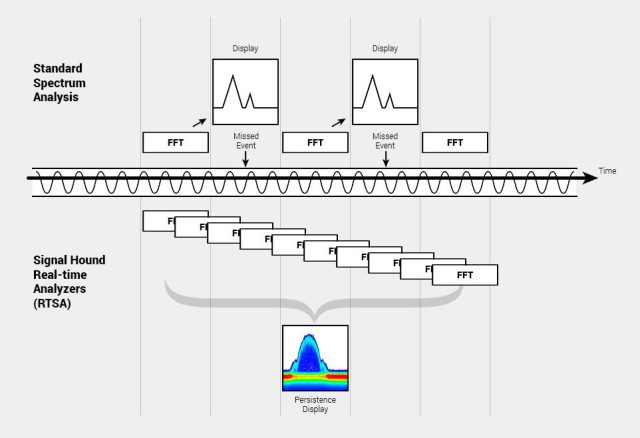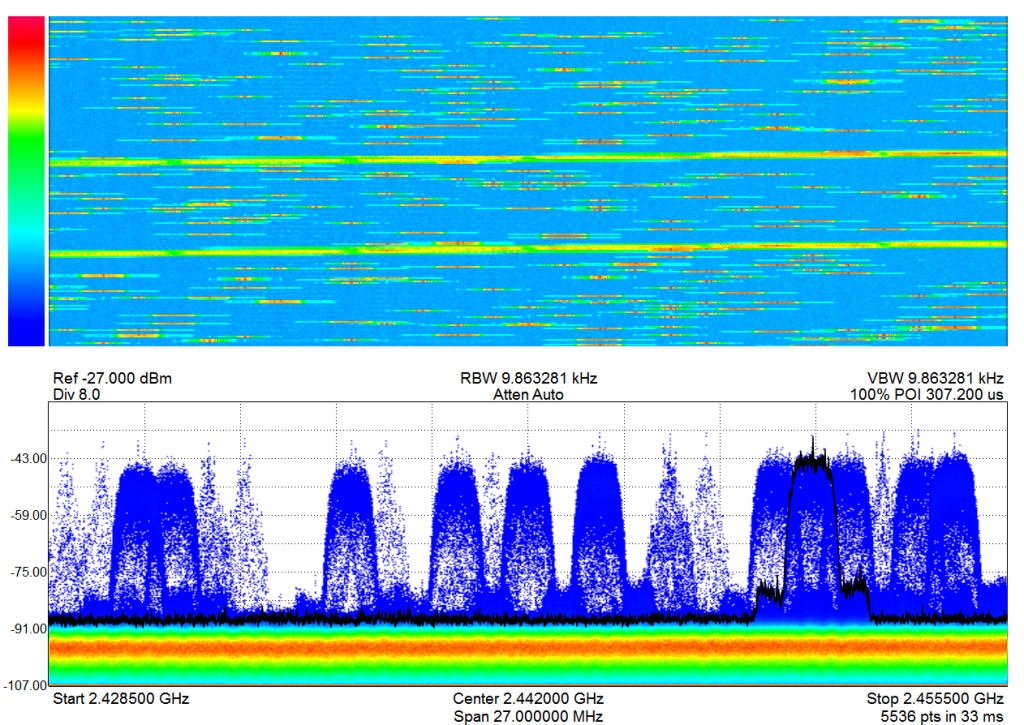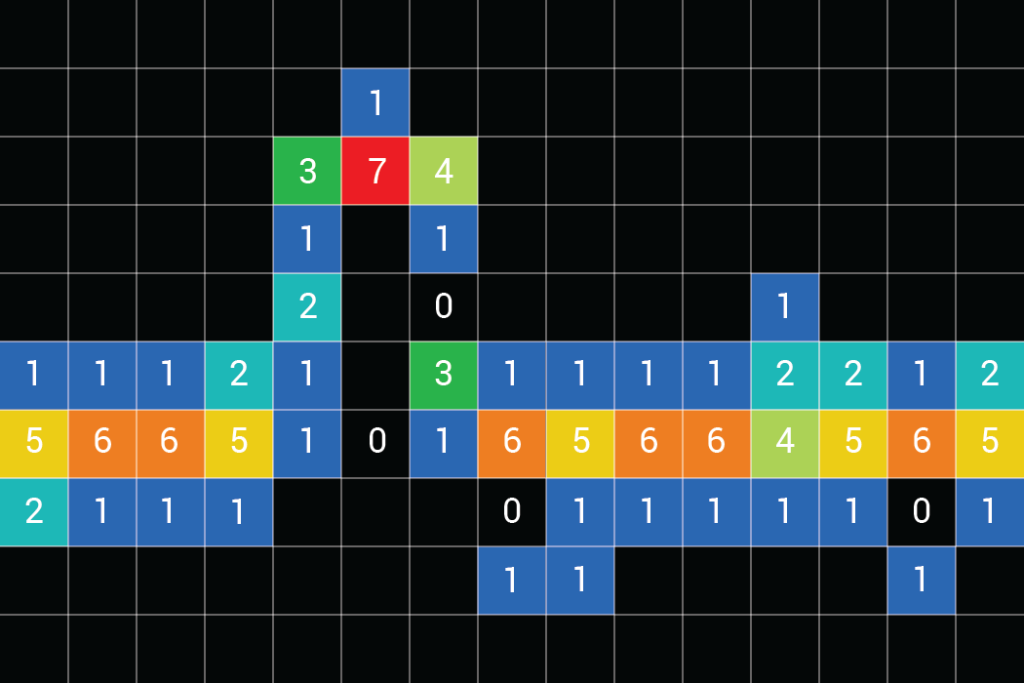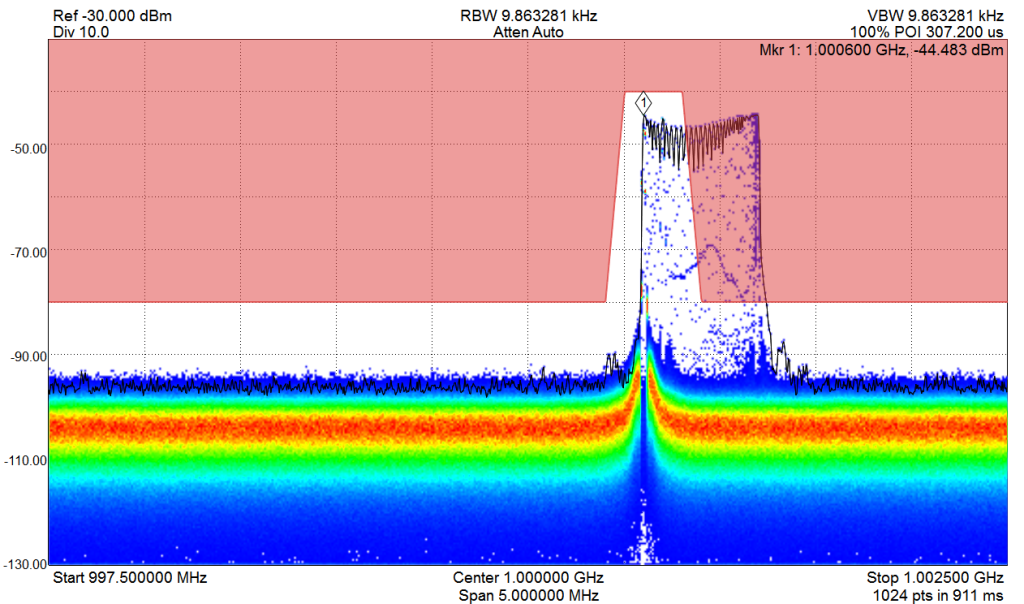This is the fourth and final post in a multi-part blog series, teaching you the essential concepts of spectrum analysis.
With the advent of wide bandwidth analog-to-digital converters (ADCs), high-speed memory, fast processors, and efficient fast-fourier transforms (FFTs), tens to hundreds of megahertz of instantaneous bandwidth can be processed as fast as it is received. Using overlapping FFTs on a continuous stream of input data produces a real-time representation of an active frequency spectrum. These modern advances enable the effective sensing and processing of the most complicated modern communications techniques, and ensure intercept of nonrecurring waveforms or pulse signals.
What’s The Difference Between Real-Time Spectrum Analysis And Spectrum Analysis?
The majority of real-world signals—from complex modulated communications signals, to interference events, and to pulsed tactical signals—the signal energy can be sporadic, non recurring, or even random. With traditional spectrum analysis, these signals could be nearly impossible to “catch” in an analysis window and trigger on. Present and future communication modulations are increasing the challenge further with techniques, such as frequency hopping, spread spectrum, pulsed, and cognitive radio techniques. Additionally, in order to analyze the quality of these communications, the ability to rapidly process, store, and compare these signals over time is necessary.
Real-time SA (RTSA) is a new method that leverages overlapping FFTs and high-speed memory to have a 100% probability of intercept (POI) in even extremely dense environments. Real-time bandwidth, the maximum frequency span offering gap-free overlapping FFT processing, is an important variable parameter of an RTSA that can enable more detailed analysis of a spectrum, based upon the type of signal content under scrutiny.

Leveraging 50% overlapping FFTs, Signal Hound RTSAs can capture frequency events with 100% probability.
What Are Some RTSA Limitations?
For low duty cycle signals, an RBW that is too large may allow for too great a noise floor and corrupt the narrow spurious or pulsed signal energy. However, an RBW that is too narrow may prevent adequate time for the signal energy to be represented accurately. Thus, the POI is rated at 100% for RF pulse events of a minimum length of time. For 100% POI, a signal must have a duration long enough to guarantee its presence in an entire FFT.
How Are Modern Signal Modulation Techniques And Infrequent/Inconsistent Signals Observed By RTSA?
Though an RTSA may be able to capture a low duty cycle or random signals of short duration, these could be challenging for a user to observe in real time in a regular display. For example, increasing the strength of a communication signal at the receiver to background noise and interference by dispersing the modulated signal power over a wider bandwidth—a technique known as spread-spectrum modulation—is used by Bluetooth, Wi-Fi, and even GPS technologies. Additionally, in military and defense applications, such as radar, electronic signal intelligence (ELINT), and electronic warfare (EW), RTSA enables the capture of signals that occur rarely or randomly and could be missed when observing a RTSA output.

The persistence and waterfall display in real-time analysis show the occupancy of the 2.4 GHz ISM band. Shown are the transmissions of a bluetooth headset and a cell phone searching for a wireless network.
For these reasons, RTSAs are now commonly equipped with persistent displays. This display method adds a measure of significance—usually based upon a color pattern corresponding to the amplitude at a single frequency over time—to signal energy as specific frequencies that occur over time. The Real Time Frame Rate selection can be used to adjust the number of FFTs that are combined to return a persistent spectrum frame. An example of a persistent display is a waterfall display. Frequency hopping technologies, such as Bluetooth, can be observed with this display, as each signal analysis sweep is colored based on signal strength and stacked as a thin line sequentially to form a time map.

As FFTs are processed in real time, persistence mode accumulates statistical data of the spectrum and displays it as a density map.
What Advanced Capabilities Do RTSAs Have?
Some RTSAs also enable a feature that can record the output of a processed spectrum for future, deeper, analysis. RF recording can be valuable when analyzing the performance of radio equipment over time, or developing descriptions of potential interference events while spectrum monitoring.
Editors Note 2018/01/30— As of Spike version 3.1.12, frequency mask trigger (FMT) functionality is merged with Limit Line functionality. The information below still applies, but within the Limit Lines feature.
Another tool that is only possible with RTSA technology, is the frequency mask trigger (FMT). This trigger technology is based upon the in-band power of the spectrum and can trigger when a spectral region is perturbed, a high/low limit, or a logic event. An FMT is non-time aligned and may have a timing resolution of 1 divided by the FFT period, which may be significantly longer than real-time without frequency mask triggering in Spike due to U.S. export regulations.

The frequency mask trigger utilized in real-time analysis captures the spurious emissions of a signal generator output when stepping in frequency.
Further Reading
Looking for more information about real time spectrum analysis? We’re wrapping up our series with this article, but trust us— we’ve got more coming in the near future! Also, be sure to check out the great resources in the list of links below. RTSA is a fascinating topic, and there is no shortage of helpful information available on the web.
References
- http://literature.cdn.keysight.com/litweb/pdf/5991-2779EN.pdf?cmpid=zzfindreal-time4wireless
- http://pages.anritsu-emearesponse.com/WF-2015-Spectrum-Guide.html
- https://www.mathworks.com/examples/signal/mw/signal_product-FrequencyAnalysisExample-practical-introduction-to-frequency-domain-analysis
- http://www.ni.com/tutorial/3541/en/
- http://literature.cdn.keysight.com/litweb/pdf/5991-4317EN.pdf
- http://www.keysight.com/upload/cmc_upload/All/24April2013WebcastSlides.pdf?&cc=US&lc=eng
9 Comments
Clear and well written article.
This mean a big rtsa from company.
Many compliments.
I hope in the future to use your RTSA.
I sort of lost the connection in the last sentence: “An FMT is non-time aligned and may have a timing resolution of 1 divided by the FFT period, which may be significantly longer than real-time without frequency mask triggering in Spike due to U.S. export regulations.” What??? What is due to U.S. export restrictions? Spike software? Some version of it? Color me confused.
Hi Lawrence,
I agree, that last sentence is kind of confusing. Basically, there are export restrictions regarding FMT which we have to avoid when using FMT in real-time analysis. We have a short article on this very topic here
https://signalhound.com/news/how-we-implemexport-controls/
I apologize for the confusion. Let me know if you have further questions.
Regards,
A.J.
I bought SA44B+TG44A 5 years ago and both are still unpact. Now I see that it’s time to start using them. So I’ll try them and if they don’t satisfy me I’ll think about RTSA, thanks about the info,73! UA3BL
Hi Chermen,
Wow, those are some early units. It might be from the first batch of SA44Bs. Let us know if you have questions setting them up. You will probably need a firmware upgrade to use our latest software. You can email support @ signalhound with questions as you get going. Get the latest software and user manual at http://www.signalhound.com/Spike
Regards,
A.J.
Hi Andrew,
Just got Spectrum analyzer (USB – SA124B) and Tracking Generator (USB-TG124A)
I used the Spectrum it was really nice and very interested to me as i was using Agilent E4411B, very big and heavy one, specially when i was going to the field for maintenance. so thanks to the company for keeping us updated with the modern tools technology.
one thing i would like to mention that i did not try to join TG with the Spectrum analyses. and i think its an extra item.
do you think it could be useful for me or i should return it back.
many thinks.
Hi Umari,
We have a 30 day return policy. If you don’t think you will use the TG124, you can return it up to 30 days from purchase.
I’m glad you are enjoying the SA124.
Let me know if you have further questions.
Regards,
A.J.
The two paragraphs in the “What Are Some RTSA Limitations?” section are duplicates. Was the second paragraph intended to be about ‘high duty cycle signals’?
Regards
BillK
Whoops! Thanks for the notification Bill! It should be fixed now 🙂